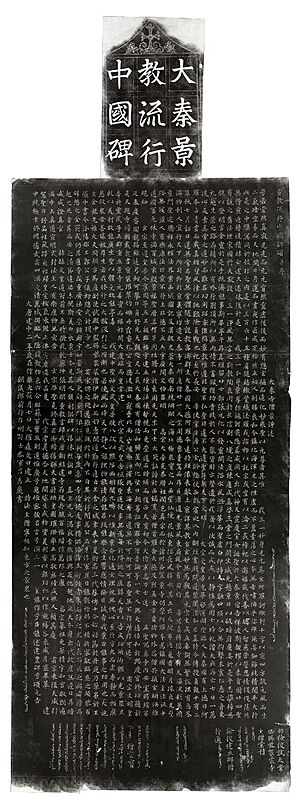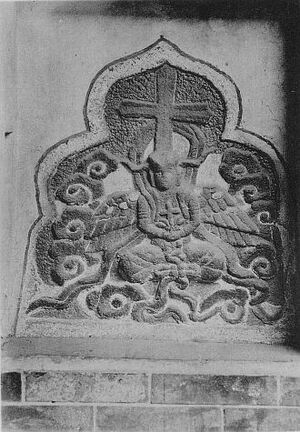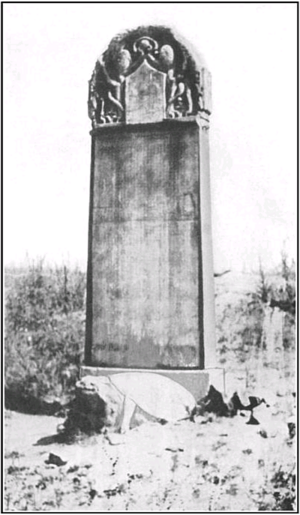Xi'an Stele facts for kids
Quick facts for kids Xi'an Stele |
|||||||||||||||
|---|---|---|---|---|---|---|---|---|---|---|---|---|---|---|---|

The stele entitled 大秦景教流行中國碑 was erected in China in 781.
|
|||||||||||||||
| Traditional Chinese | 大秦景教流行中國碑 | ||||||||||||||
| Simplified Chinese | 大秦景教流行中国碑 | ||||||||||||||
| Literal meaning | Stele to the Propagation in China of the Jingjiao (Luminous Religion) of Daqin (Roman Empire) | ||||||||||||||
|
|||||||||||||||
| Alternative Chinese name | |||||||||||||||
| Chinese | 景教碑 | ||||||||||||||
| Literal meaning | Luminous Religion Stele | ||||||||||||||
|
|||||||||||||||
The Xi'an Stele (pronounced Shee-ahn Steel) is a famous stone tablet from ancient China. It is also known as the Jingjiao Stele. This large stone was put up in the year 781 during the Tang dynasty. It tells the story of how Christianity first came to China. The stele shares details about 150 years of early Christian history in the country.
This important stone is made of limestone and stands about 2.79 meters (9 feet) tall. It has writing in two languages: Chinese and Syriac. The text describes Christian groups living in several cities in northern China. It explains that the early Christian church, called the Church of the East, was recognized by the Chinese emperor. This happened because of a Christian missionary named Alopen. He arrived in China in 635. The stele says that Alopen and other missionaries came from a place called Daqin. This was the Chinese name for the Eastern Roman Empire. They brought religious books and pictures with them. A monk named Adam (also known as Jingjing) wrote the text on the stele. The stele was buried in 845, likely to protect it during a time when religions were being suppressed. It was found again much later in 1625. Today, you can see the original stele in the Stele Forest museum in Xi'an.
Contents
How the Stele Was Found
The Xi'an Stele was probably buried in 845. This was during a time when the government was cracking down on religions, especially Buddhism. Other religions, including Christianity, were also affected.
The stele was dug up in the early 1600s, between 1623 and 1625. It was found near a temple called Chongren Temple, just outside the city of Xi'an. Workers who found the stele quickly told the local governor. The governor visited the stone and had it placed on a stand. He also had a roof built over it to protect it. He asked a nearby Buddhist temple to look after it.
The discovery of the stele caught the attention of smart people in the area. A scholar named Zhang Gengyou was the first to realize the text was about Christianity. He had learned about Christianity from another scholar, Matteo Ricci. Zhang sent a copy of the Chinese text to his Christian friend, Leon Li Zhizao. Leon then shared the text with Jesuit missionaries who were living in China.
The first European to see the stele was a Jesuit named Alvaro Semedo. He visited it sometime between 1625 and 1628. Soon after, a Latin translation of the stele's writing was published in Europe. This translation helped many people learn about the stele.
What the Stele Says
The main title on the stone is in Chinese. It means Memorial of the Propagation in China of the Luminous Religion from Daqin. The "Luminous Religion" was the name the Church of the East used for itself in China. "Daqin" was the Chinese name for the Roman Empire.
Who Wrote the Stele?
The stele was put up on January 7, 781. This was in the capital city of Chang'an (which is now Xi'an). A person named Lü Xiuyan did the beautiful writing on the stone. The words themselves were written by the Church of the East monk Jingjing.
A note in Syriac on the stele identifies Jingjing as "Adam, priest, chorepiscopus and papash of Sinistan." This means he was an important leader of the Church of the East in China. The stele also lists the names of several other high-ranking church leaders. About seventy monks or priests are also named. Their names are written in both Syriac and Chinese. Some of these monks had Persian names, suggesting they came from Persia.
Key Messages of the Stele
At the very top of the stone tablet, there is a cross. Below this, there is a long Chinese inscription with about 1,900 characters. Some parts also have Syriac notes.
The text calls God "Veritable Majesty." It mentions stories from the Book of Genesis and talks about the Christian cross and baptism. It also praises the missionaries and people who supported the church. These missionaries arrived in China by 640. The text mentions the early missionary, Alopen, by name.
The stele describes the "Illustrious Religion." It talks about the Trinity (God as Father, Son, and Holy Spirit) and the Incarnation (God becoming human in Jesus). However, it does not mention Jesus' crucifixion or resurrection. The text also includes some Chinese ideas, like a wooden bell and specific hairstyles for monks.
The stele even mentions a person named Yazedbuzid (Yisi in Chinese). He helped a Chinese general named Guo Ziyi put down a big rebellion. Because of his help, Yisi and the Church of the East were rewarded by the Tang dynasty.
Debates About the Stele
When the Xi'an Stele was found, some people in the 1600s argued about it. Some thought the stone was a fake. Others believed the writing had been changed by the Jesuits. These early doubters included scholars like Georg Horn and Gottlieb Spitzel. A missionary named Domingo Navarrete also questioned it.
By the 1800s, the debate became more about history and less about religion. Many scholars studied the stele closely. Some still had doubts, but many others, after careful research, agreed that the stele was real. Important scholars like Henri Havret and Paul Pelliot did a lot of research to prove the stele's authenticity. Their work is still considered very important today.
Where the Stele Is Now and Its Copies
In the late 1800s, some European scholars thought the stele should be moved out of China. They wanted it to be in a museum like the British Museum. In 1907, a Danish adventurer named Frits Holm even tried to take the monument to Europe. But local authorities stopped him. They moved the original stele, along with its turtle-shaped base, to the Beilin Museum in Xi'an.
Holm had an exact copy of the stele made. He sent this copy to New York, hoping to sell it to the Metropolitan Museum of Art. The museum director wasn't very interested in buying "so large a stone ... of no artistic value." However, the copy was shown at the museum for about 10 years. Later, in 1917, a wealthy New Yorker named Mrs. George Leary bought the copy from Holm. She sent it to Rome as a gift to the Pope. Another copy of this replica is on display at Georgetown University in Washington, D.C.
The original Xi'an Stele is still in the Forest of Steles museum. It is now in Room Number 2. In 2003, the stele was put on a special list of Chinese cultural items that are forbidden to be shown abroad. This shows how valuable and important it is.
Other copies of the stele can be found in different places. There's one near the Daqin Pagoda in Xi'an. Another is on Mount Kōya in Japan. You can also find a copy in the Tianhe Church in Guangzhou.
Other Early Christian Finds in China

Many Christian gravestones have been found in other parts of China. These include the Xinjiang region and Quanzhou. They are from a slightly later time period than the Xi'an Stele. There are also two other steles from 960 and 1365. These stones mix Christian and Buddhist ideas. They are kept at the site of the old Monastery of the Cross near Beijing.
In 2006, a stone pillar with Church of the East writings was found in Luoyang. This is known as the Nestorian pillar of Luoyang. It was made in 815. The writings on it give some details about a Christian community from Sogdia (an ancient region in Central Asia) that lived in Luoyang.
Images for kids
-
Syriac text at the bottom of the stele.
-
Title of the stele: "Stele to the Propagation in China of the Luminous Religion (Church of the East) of the Roman Empire (Daqin)"
See also
- Church of the East in China
- Jingjiao Documents
- Adam (Jingjing)
- Nestorian pillar of Luoyang
- Mogao Christian painting
- Murals from the Christian temple at Qocho
- Central Asian objects of Northern Wei tombs






